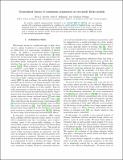Files in this item
Generalized classes of continuous symmetries in two-mode Dicke models
Item metadata
| dc.contributor.author | Moodie, Ryan | |
| dc.contributor.author | Ballantine, Kyle | |
| dc.contributor.author | Keeling, Jonathan Mark James | |
| dc.date.accessioned | 2018-02-20T15:30:06Z | |
| dc.date.available | 2018-02-20T15:30:06Z | |
| dc.date.issued | 2018-03-01 | |
| dc.identifier | 252347793 | |
| dc.identifier | e4c22cc0-1419-44a0-9887-d39063189939 | |
| dc.identifier | 85044001965 | |
| dc.identifier | 000426399900005 | |
| dc.identifier.citation | Moodie , R , Ballantine , K & Keeling , J M J 2018 , ' Generalized classes of continuous symmetries in two-mode Dicke models ' , Physical Review. A, Atomic, molecular, and optical physics , vol. 97 , no. 3 , 033802 . https://doi.org/10.1103/PhysRevA.97.033802 | en |
| dc.identifier.issn | 1050-2947 | |
| dc.identifier.other | ORCID: /0000-0002-4283-552X/work/42276821 | |
| dc.identifier.uri | https://hdl.handle.net/10023/12760 | |
| dc.description | K.E.B. and J.K. acknowledge support from EPSRC program “TOPNES” (EP/I031014/1). | en |
| dc.description.abstract | As recently realized experimentally [Léonard et al., Nature 543 , 87 (2017)], one can engineer models with continuous symmetries by coupling two cavity modes to trapped atoms, via a Raman pumping geometry. Considering specifically cases where internal states of the atoms couple to the cavity, we show an extended range of parameters for which continuous symmetry breaking can occur, and we classify the distinct steady states and time-dependent states that arise for different points in this extended parameter regime. | |
| dc.format.extent | 2033844 | |
| dc.language.iso | eng | |
| dc.relation.ispartof | Physical Review. A, Atomic, molecular, and optical physics | en |
| dc.subject | QC Physics | en |
| dc.subject | TK Electrical engineering. Electronics Nuclear engineering | en |
| dc.subject | NDAS | en |
| dc.subject.lcc | QC | en |
| dc.subject.lcc | TK | en |
| dc.title | Generalized classes of continuous symmetries in two-mode Dicke models | en |
| dc.type | Journal article | en |
| dc.contributor.sponsor | The Leverhulme Trust | en |
| dc.contributor.sponsor | EPSRC | en |
| dc.contributor.institution | University of St Andrews. School of Physics and Astronomy | en |
| dc.contributor.institution | University of St Andrews. Condensed Matter Physics | en |
| dc.identifier.doi | https://doi.org/10.1103/PhysRevA.97.033802 | |
| dc.description.status | Peer reviewed | en |
| dc.identifier.grantnumber | IAF-2014-025 | en |
| dc.identifier.grantnumber | EP/I031014/1 | en |
This item appears in the following Collection(s)
Items in the St Andrews Research Repository are protected by copyright, with all rights reserved, unless otherwise indicated.

